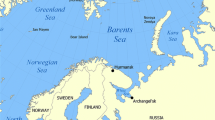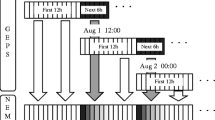Abstract
We have explored the predictability of storms in a small enclosed basin with a complicated surrounding orography. We have considered two exceptional storms in the far past and three mild events happened in recent years. A posteriori forecasts have been done up to 6 days before the events. The results have been compared versus measured data and the related analysis. Good predictability (10–15% error in surface wind speed and wave height) have been found up to day 4, mildly larger (<30%) up to day 6 before the event. In no case was a storm missed. This suggests that the effective predictability in more open basins may extend to even larger ranges.








Similar content being viewed by others
References
Bajo M, Umgiesser G (2010) Storm surge forecast through a combination of dynamic and neural network models. Ocean Model 33(1–2):1–9
Beljaars A, Bechtold P, Kohler M, Morcrette J-J, Tompkins A, Viterbo P, Wedi N (2004) The numerics of physical parameterization. Published in the Proceedings of the ECMWF Seminar on “Recent developments in numerical methods for atmospheric and ocean modelling”, 6–10 September 2004, pp.113–134 (available from ECMWF, Shinfield Park, Reading RG29AX, UK, or from the web at http://www.ecmwf.int/publications/library).
Bertotti L, Cavaleri L (2009) Wind and wave predictions in the Adriatic Sea. J Mar Syst. doi:10.1016/j.jmarsys.2009.01.018
Bertotti L, Cavaleri L, De Simone C, Torrisi L, Vocino A (2010) Il sistema di previsione del mare “NETTUNO”, Rivista di Meteorologia, Jan_Mar 2010, 25–36
Bertotti L, Bidlot J-R, Buizza R, Cavaleri L (2011) Deterministic and ensemble-based prediction of Adriatic Sea sirocco storms leading to “acqua alta” in Venice. Quart J Royal Meteorol Soc (in press)
Buizza R, Leutbecher M, Isaksen L (2008) Potential use of an ensemble of analysis in the ECMWF Ensemble Prediction System. Quart J Royal Meteorol Soc 134:2051–2066
Cavaleri L (2000) The oceanographic tower Acqua Alta—activity and prediction of sea states at Venice. Coastal Eng 39:29–70
Cavaleri L, Bertotti L (1996) In search of the correct wind and wave fields in a minor basin. Mon Weather Rev 125(8):1964–1975
Cavaleri L, Bertotti L (2006) The improvement of modelled wind and wave fields with increasing resolution. Ocean Eng 33(5–6):553–565
Cavaleri L, Sclavo M (2006) The calibration of wind and wave model data in the Mediterranean Sea. Coastal Eng 53:613–627
Cavaleri L, Bertotti L, Buizza R, Buzzi A, Masato V, Umgiesser G, Zampieri M (2010) Predictability of extreme meteo-oceanographic events in the Adriatic Sea. Quart J Royal Meteorol Soc. doi:10.1002/qi.567
Cushman-Roisin B, Gacic M, Poulain P-M, Artegiani A (2001) Physical oceanography of the Adriatic Sea: past, present and future, Kluwer Academic Publishers, 306 pp
De Zolt S, Lionello P, Nulm A, Tomasin A (2008) The disastrous storm of 4 November 1966 on Italy. Nat Hazards Earth Syst Sci 6(5):861–879
Frogner I-L, Haakenstad H, Iversen T (2006) Limited-area ensemble predictions at the Norwegian Meteorological Institute. Quart J Royal Meteorol Soc 132:2785–2808
Horsburgh K, Williams J, Flowerdew J, Mylne K (2008) Aspects of operational forecast model skill during an extreme storm surge event. J Flood Risk Management 1(4):213–221
Hortal M (2004) Overview of the numerics of the ECMWF atmospheric forecast model. Published in the Proceedings of the ECMWF Seminar on “Recent developments in numerical methods for atmospheric and ocean modelling”, 6–10 September 2004, pg. 1–14 (available from ECMWF, Shinfield Park, Reading RG29AX, UK, or from the web at http://www.ecmwf.int/publications/library).
Janssen PAEM (2008) Progress in ocean wave forecasting. J Comput Phys 227(7):3572–3594
Komen GJ, Cavaleri L, Donelan M, Hasselmann K, Hasselmann S, Janssen PAEM (1994) Dynamics and modelling of ocean waves, Cambridge University Press, 532 pp
Lorenz EN (1963) Deterministic nonperiodic flow. J Atmos Sci 20:130–141
Malguzzi P, Grossi G, Buzzi A, Ranzi R, Buizza R (2006) The 1966 ‘century’ flood in Italy: a meteorological-hydrological revisitation. J. Geoph. Res., 111, D24106, pp.1–15
Marsden RF (1987) A comparison between geostrophic and directly measured surface winds over the Northeast Pacific Ocean. Atmos Ocean 25(4):387–401
Montani A, Cesari D, Marsigli C, Paccagnella T (2010) Seven years of activity in the field of mesoscale ensemble forecasting by the COSMO-LEPS system: main achievements and open challenges. Tellus 63(3):605–624
Robinson AR, Tomasin A, Artegiani A (1973) Flooding of Venice: phenomenology and prediction of the Adriatic storm surge. Quart J Royal Meteorol Soc 99:688–692
Signell RP, Carniel S, Cavaleri L, Chiggiato J, Pullen J, Sclavo M (2005) Assessment of wind qualità for oceanographic modelling in semi-enclosed basins. J Mar Syst 53(1–4):217–233
Umgiesser G, Melaku CD, Cucco A, Solidoro A (2004) A finite element model for the Venice lagoon. Development, set-up, calibration and validation. J Mar Syst 51:123–145
Acknowledgements
Most of the computations mentioned in this paper have been carried out at the European Centre for Medium-Range Weather Forecasts, Reading, UK. We acknowledge with pleasure their professional help, in particular the one offered by the local User Support group.
This work has been partially supported by the EquiMar project, a collaborative project under the European Community FP7, grant agreement n. 213380, and FIELD-AC, Fluxes, Interactions and Environment at the Land–Ocean Boundary. Downscaling, Assimilation and Coupling, Grant Agreement FP7-242284.
Author information
Authors and Affiliations
Corresponding author
Additional information
Responsible Editor: Michel Rixen
This article is part of the Topical Collection on Maritime Rapid Environmental Assessment
Appendix A
Appendix A
Intercomparison of two vector fields
We want to intercompare two vector fields on the same grid, say b with respect to a (see Marsden 1987). We consider each vector as a complex number, i.e. a = [ax,ay] → (ax + i ay) = a exp(iΦ), with a the modulus and Φ the phase. If we have only one vector (i.e. one-grid point)
provides the ratio of the moduli and the phase difference. The result of a point-by-point comparison of the two fields is another vector field. To summarise this result in a more compact way, we can proceed as follows. Obviously
with a* the complex conjugate of a. We consider the quantity
Ψ can be considered as the regression coefficient of the b field with respect to a. If we consider also the expression
this can be interpreted as a sort of minimum square quantity. Alternatively, Ψ is the quantity that minimises the distance between the two points [b i ] and [Ψa i ] in an n dimensional space (i = 1–n).
The complex number
provides the ‘average’ ratio and the ‘average’ phase difference between the two fields.
Rights and permissions
About this article
Cite this article
Bertotti, L., Cavaleri, L. The predictability of meteo-oceanographic events. Ocean Dynamics 61, 1391–1402 (2011). https://doi.org/10.1007/s10236-011-0433-4
Received:
Accepted:
Published:
Issue Date:
DOI: https://doi.org/10.1007/s10236-011-0433-4




